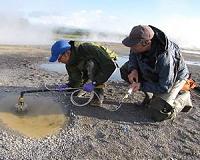| . |  |
. |
Durham NC (SPX) May 03, 2011 Lichen, those drab, fuzzy growths found on rocks and trees, aren't as cuddly and charismatic as kangaroos or intriguing as opossums, but they could be a fungal equivalent, at least evolutionarily. A Duke research team has found that lichen that seem identical in all outward appearances and produce the same internal chemicals are in fact two different species, one living in North America and one in Australia. They're an example of "convergent evolution," in which two species evolve separately but end up looking very similar, like the Tasmanian wolf and the American wolf. The lichens developed the same adaptations to survive and thrive in vastly different regions of the world. Since they show the same evolutionary patterns as marsupials and mammals, but are easier to study, they could become model organisms to further probe how mammals and other groups of organisms evolve, said Duke biologist Brendan Hodkinson. "Lichen can often seem dull and uncharismatic, but these two species turned out to be quite intriguing," said Hodkinson, a graduate student in the lab of Duke lichenologist Francois Lutzoni. "They're like sugar gliders and flying squirrels or wombats and groundhogs. They're fungal examples of convergent evolution." Scientists originally labeled specimens from both continents Xanthoparmelia tasmanica, which, like all lichen, is a type of fungus that "farms" algae. The lichen specimens were thought to be one species because they shared the same body plan and produced the same chemicals. But given the lichens' geography and the natural history of other species, some scientists still questioned whether the organisms were truly identical, even though previous tests showed that they were. When the question came up again in 2009, Hodkinson and James Lendemer of the New York Botanical Garden gathered lichen samples from North America and Australian specimens preserved in herbariums at Duke and the New York Botanical Garden to find out. They studied the organisms' body structure and chemical composition and also found no difference. But then the lichenologists looked at the organisms' DNA, which nobody had done before. Hodkinson and Lendemer used this analysis and computer modeling of the lichens' evolution to digitally reconstruct a family tree. The tree clearly showed that the Australian lichen evolved on a branch completely separate from the North American lichen, suggesting that the organisms are separate species. The lichenologists describe their work and rename the North American lichen species Xanthoparmelia hypofusca, following past lichen literature, in a paper that appears in the latest issue of the journal Bibliotheca Lichenologica. Hodkinson added that lichen are important for another reason. Like canaries in a noxious coal mine, lichen die when the air is unhealthy. Scientists have already seen some species disappear in Europe since the beginning of the Industrial Revolution. A few were hardy and came back when air quality improved, but "we may not always be that lucky and we could see some lichen go the way of the Tasmanian wolf - extinct," he said.
Share This Article With Planet Earth
Related Links Explore The Early Earth at TerraDaily.com
 Siberian hot springs reveal ancient ecology
Siberian hot springs reveal ancient ecologyChicago IL (SPX) Apr 28, 2011 Exotic bacteria that do not rely on oxygen may have played an important role in determining the composition of Earth's early atmosphere, according to a theory that UChicago researcher Albert Colman is testing in the scalding hot springs of a volcanic crater in Siberia. He has found that bacteria at the site produce as well as consume carbon monoxide, a surprising twist that scientists must ... read more |
|
| The content herein, unless otherwise known to be public domain, are Copyright 1995-2010 - SpaceDaily. AFP and UPI Wire Stories are copyright Agence France-Presse and United Press International. ESA Portal Reports are copyright European Space Agency. All NASA sourced material is public domain. Additional copyrights may apply in whole or part to other bona fide parties. Advertising does not imply endorsement,agreement or approval of any opinions, statements or information provided by SpaceDaily on any Web page published or hosted by SpaceDaily. Privacy Statement |